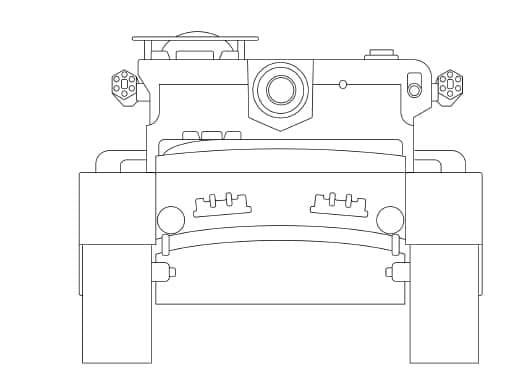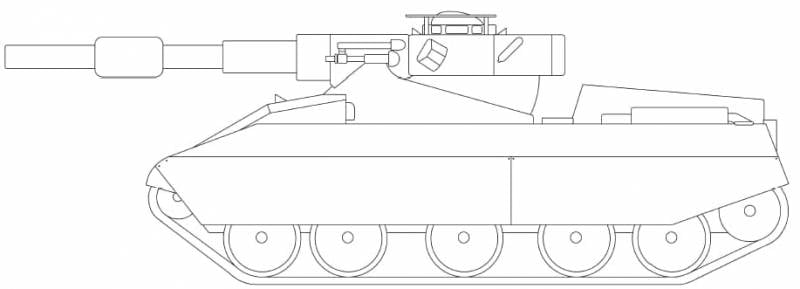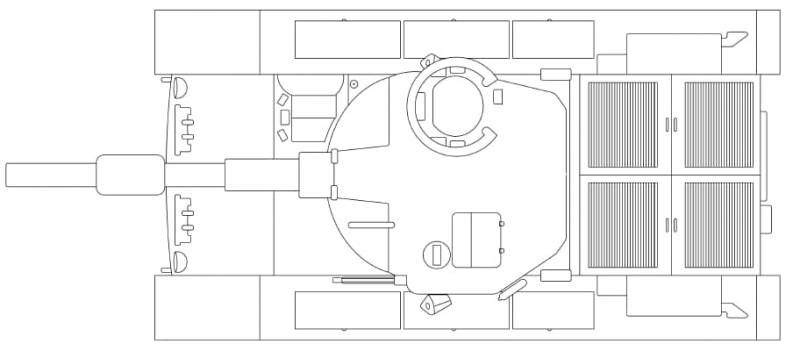Project Caliban. Atomic tank in British
In the early sixties, the basis of the armored forces of the British army were heavy tanks FV 214 Conqueror and the medium / main A41 Centurion. It was assumed that in a general combat battle, the heavy Conqueror would detect and attack the most difficult and priority armored vehicles of the enemy. The task of the "Centurion" in this case became the joint work with the infantry and its protection from other armored vehicles. In addition, since the end of the fifties, tests were conducted on the promising main tank, the Chieftain, which in the foreseeable future was to go into service.
The available armored vehicles, in general, suited the command, but there were some complaints. The combatant tanks of the two main types had insufficient mobility and could not reach the specified area in the shortest possible time. In addition, they could not be thrown through the air. The characteristics of fire and protection still met current requirements, but this situation could not last forever.
The situation was complicated by the fact that reconnaissance reported on the work being done in the Soviet Union to create fundamentally new types of armored vehicles capable of displaying outstanding combat qualities. It was obvious that the existing Conqueror and Centurion would become obsolete in the foreseeable future and require replacement. In the near future, they should have been replaced by Chieftain, but this did not exclude the need to work out new projects, at least at the level of theory.
Against the background of current events and expected calls, it was decided to work out a fundamentally new tank with special capabilities. The development of this armored vehicle was commissioned to the Royal Military College (Royal Military College of Science), namely, its School of Tank Technology (School of Tank Technology). In the near future, it was supposed to present the overall appearance of the tank and solve some design problems. When obtaining the desired results, the project could be developed and reach the construction of experimental or serial equipment.
The military department wanted to get a promising armored vehicle capable of accompanying and supporting motorized rifle units on the battlefield in times of conflict in the European theater of operations. The tank had to accompany the armored personnel carriers, which made known requirements for its mobility. At the same time, he was to receive protection from small-caliber and tank guns, as well as to be able to defeat light armored vehicles and enemy tanks. At the same time, it was necessary to reduce the size and combat weight of the machine to increase strategic mobility.
After studying the requirements, the staff of the Royal Military College came to the obvious conclusions. The new project could be based on already known and proven solutions, but it was necessary to use fundamentally new ideas. Only by combining old and new ideas was it possible to create a lightweight tank with powerful armor and high firepower. Began the search for new proposals, and soon it allowed to form the appearance of the future machine. Calculations showed that the new tank will have advantages over all existing British and foreign vehicles.
The new project, while being worked out only in theory, was named Caliban. The car was named after the character of William Shakespeare's play The Tempest. It soon became clear that this name is quite suitable for a combat vehicle. She, like her "namesake," loomed not too beautiful, but at the same time powerful and dangerous for the enemy.
In the project "Kaliban" it was planned to use the traditional layout of the hull and the tower of the swinging type. The car should have been distinguished by special outlines of the tower and weapons. To obtain high combat characteristics, the designers proposed to increase the caliber of the gun in comparison with the existing tanks. The rest of the projected tank was similar to the existing and promising samples.
The project involved the construction of a classic-style armored hull with a front-mounted driver, a central fighting compartment and aft engine compartment. The corps received differentiated reservations with the maximum possible frontal projection protection and anti-bullet barriers in other areas. The forehead of the body was made up of three parts. The top two had a thickness of 130 mm and were located at an angle of 70 ° (upper) and 60 ° (medium) to the vertical. The 30-mm bottom sheet was tilted 40 ° forward. The maximum reduced thickness of such armor reached 260 mm. The joint of the middle and lower parts of the reservation was proposed to be curved, which could further increase the rigidity and strength of the structure.
Vertical sides were connected with the forehead of the wedge-shaped profile, as well as horizontal roof and bottom. The stern leaf slid back slightly. Above the engine compartment provided box, increasing its volume. Maximum side and stern projection protection was provided by 25-mm sheets. Parts of thickness 10 mm were also used. Thus, when firing from the side, behind or from above, the Caliban tank could withstand only bullets or fragments.
Special armament made designers from the Royal Military College of Science use a rocking type turret. Directly on the hull of the hull, they placed a fixed tower assembly with a higher inclined frontal part, and behind it was a sloping section. A rigidly mounted gun mount was placed in the swinging part of the tower with rectangular contours, complemented by a lower rounded device that interacts with the fixed element of the tower. The horizontal aiming of the guns was to be carried out by turning the whole tower. For the vertical guidance answered swinging part of the tower. With its help, it was possible to raise the weapon by 20 ° or lower it by 12 °.
In the stern of the hull it was proposed to place the Meteorite Mk.202 gasoline engine. Through the clutch of the Borg and Beck brand, torque was applied to the Z5 Merritt Brown gearbox, and then to the drive wheels of the aft layout. The power plant was also completed with a pair of 4 kW electric generators each.

Chassis received five road wheels on each side. Used independent torsion suspension with spring shock absorbers. To optimize the load on the chassis, the rollers were installed at different intervals. As a result, the distance between the first two rollers was minimal, the second and third intervals were increased, and there was an average interval before the fifth roller. In front of the hull there were guide wheels, in the stern - leading ones. Chassis covered with side screens.
In accordance with the requirements, "Kaliban" should have increased firepower. Studies have shown that fundamentally new weapons are needed to solve such a design problem. Soon, the overall appearance of a tank gun was formed, providing advantages over British and foreign tanks. In the future, the achievements of the military college could be developed in the form of a real project.
In the tower, motionless, without means of vertical guidance, it was necessary to mount a gun caliber 160 mm. A gun with an ejector should have been installed on recoil devices with the required characteristics. Calculations showed that the ammunition for such a weapon would be excessively heavy, and tankers would not be able to work effectively with them. In this regard, the gun should be equipped with automatic loader. To simplify the design of the latter, the designers proposed to abandon the metal sleeve in favor of the burning silk case. Inside the fighting compartment was able to place the automatic loader with cells for 30 shots.
The main ammunition tank Caliban was to be 160-mm armor-piercing high-explosive shell. Such a product could have a mass of 60 pounds (27,25 kg), most of which fell on the explosive. According to calculations, the ballistics of such a projectile made it possible to effectively strike existing Soviet tanks at distances up to 2 thousand yards (1830 m). At a distance of 1000 yards (914 m), the probability of hitting the tank exceeded 98%, and by 1500 yards (1370 m) it decreased to 88%.
Also, the tank was planned to equip high-explosive shells to fight the infantry or fortifications. Apparently, such an ammunition in mass and power could be like an armor-piercing high-explosive. At the same time, he could show the most significant advantages over serial 105- and 120-mm tank shells.
Of particular interest in the new project weapons represented the third type of projectile. The caliber 160 mm gave an increase in the volume inside the projectile, and for this reason, the designers proposed to develop a special weapon with a low-power nuclear charge. Unfortunately, there is no detailed information about such a shot. Apparently, the nuclear projectile for the "Kaliban" has not left the stage of discussion of the possibility of its creation.
Auxiliary armament of the tank was to consist of two machine guns rifle-caliber, which are subject to special requirements. The weapon should have the minimum size of the units located inside the tank, as well as throwing the liner out. First of all, this was due to the peculiarities of the compartment under the twin machine gun. Because of the limited space inside the fighting compartment, it was proposed to be mounted at the left side of the turret, with the barrel outside the dome. The second machine gun was proposed to be installed on the turret installation above the commander's hatch. For her, on the roof of the tower provided for the annular guide. On the sides of the tower should install two blocks of smoke grenade launchers.
The introduction of the automatic loader allowed the crew to be reduced to three people. One of them, a driver, was located in front of the hull, on the starboard side. Above his workplace in the upper front sheet provided its own hatch. According to the traditions of the British tank building, the body hatch was made double-wing. The driver had three periscopic devices ready for use. Each of them had a clip with a pair of optical elements. In the event of damage to the element used, for example, due to a nuclear explosion, the driver could turn the clip and bring a new optics into the working position.
In the tower, on the sides of the gun, were the gunner (left) and the commander (right). Above their seats there were own hatches with one or another additional equipment. So, the gunner was asked to use a rotary periscope, and the commander was supposed to have a low turret with optics around the perimeter.
Unfortunately, the assumed dimensions and weight of the tank remain unknown. It can be assumed that the “Caliban” should not have surpassed other tanks of its time. The mass probably could be within 30-35 t, which was associated with the requirements for strategic mobility in part of the bridges. On road performance, the new tank was required to outperform the existing ones. Recall that the heavy Conqueror and the average Centurion could reach speeds of just 35 km / h. On the battlefield, the Caliban tank was to accompany light infantry armored vehicles capable of developing higher speeds.
Employees of the School of Tank Technology from the Royal Military College of Science worked on the look of a promising tank with special capabilities and prepared a set of necessary documents. Then they were submitted to the military department for analysis. Soon after it story Caliban project is over. The command of the British army did not want to launch a full-fledged development of a new project, not to mention the transfer of armored forces to similar equipment.
A few years later, the main battle tank Chieftain was adopted. It was a variant of the further development of the Centurion tank with the use of modern technologies and components, and therefore did without radically new solutions. In terms of tactical and technical characteristics - especially in firepower - “Chieftain” was significantly inferior to “Caliban”, but at the same time it had significant advantages in other areas. So, when the Caliban project was at the stage of formation of the appearance, the future serial tank was already tested. In addition, the industry could launch its mass production in the shortest time possible, without encountering serious difficulties.
It is understandable why the army eventually chose the existing and relatively simple tank, abandoning a promising armored vehicle, which existed only in the form of the most general provisions and solutions. An overly bold project was sent to the archive and forgotten. To the delight of lovers of armored vehicles, he was discovered. The British historian of armored vehicles, Ed Francis, not so long ago found in the archives information about the "Calibane", and the general public finally found out about an interesting project.
***
Assessing the design of the average Caliban tank is quite simple. It was interesting from the point of view of the main proposals and the alleged fighting qualities, but at the same time it was characterized by excessive innovation and obvious technological risks. If, in the area of chassis and protection, mainly known and tested solutions were used, then in the field of armament all known risks could be fully manifested.
To obtain the highest fire characteristics, the Kaliban tank required a fundamentally new 160-mm gun and ammunition for it. This means that British industry needed to develop the full range of tools, from the gun itself to fire control systems, etc. One can imagine how complicated, expensive and long a program would be to create a new gun. In this case, the development of a promising nuclear projectile could be of particular difficulty. As a result, it was impossible to exclude such a scenario, in which this project could be completed without the expected results, but with the loss of time and money.
With all this it should be borne in mind that the Caliban tank could not get another weapon. Replacing the 160-mm cannon with other weapons, for example, the existing model, deprived the tank of prospects. In this case, he risked being just another competitor of existing and developed machines. Moreover, without any special or decisive advantages over them.
The new version of the appearance of a promising tank, proposed in the project with the working title Caliban, turned out to be too difficult to implement and did not guarantee success. In the presence of less daring but realistic alternatives, this predetermined his fate. The command of the British army got acquainted with the development of the Royal Military College and made its decision. The development of British armored troops continued without revolutionary new projects.
Based on:
https://facebook.com/TheFriendsofTheTankMuseum/
http://alternathistory.com/
https://warhead.su/
http://tanks-encyclopedia.com/


Information